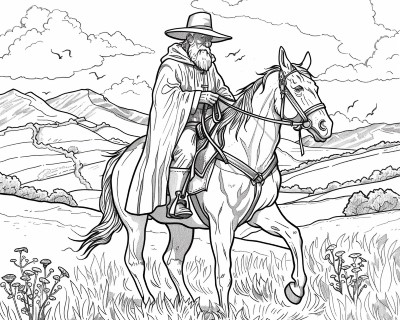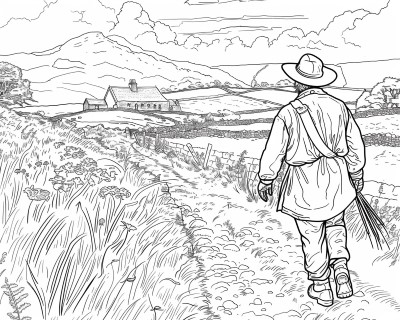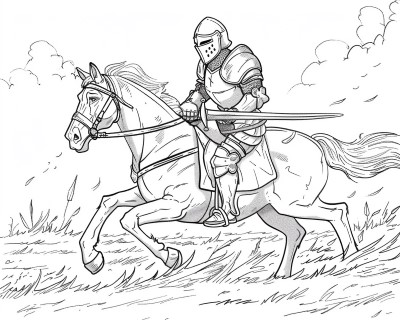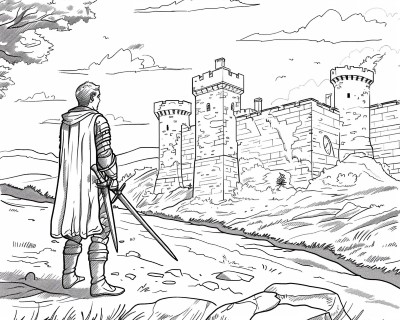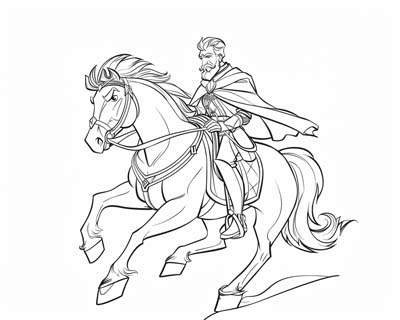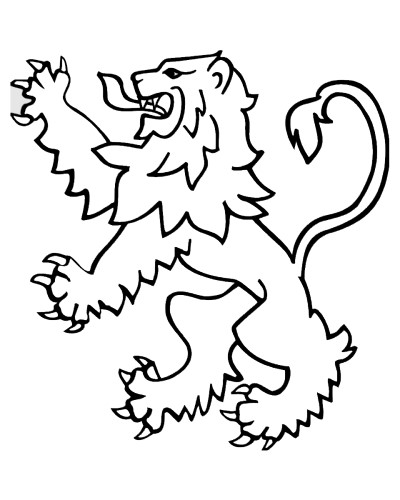Printable Coloring Pages
Owain Glyndŵr Coloring Pages
Welcome to our Owain Glyndŵr coloring pages section, where you can explore the life and legacy of one of Wales' greatest heroes. Owain Glyndŵr, known as "Owen Glendower" in Shakespeare's "Henry IV, Part 1," declared himself Prince of Wales and led a valiant fight for Welsh independence in the early 15th century.
These coloring pages invite you to step back into history and bring to life the legendary tales of Glyndŵr's brave campaigns, his rise as Prince of Wales, and his enduring spirit that still inspires the Welsh nation today. Unleash your creativity as you color scenes depicting his journey, his battles, and the landscapes of his beloved homeland.
Owain grew up in Wales as the son of a noble man, exploring the Welsh countryside the way most young boys would!When he grew up to be a man, he began to feel that the English who ruled over his land weren't kind or fair to his Welsh countrymen.
Owain Glyndŵr served in the English military earlier in his life. He fought under the English banner during campaigns in Scotland and possibly in France, gaining valuable military experience that he would later use during his own rebellion against English rule in Wales.
When Owain returned to Wales, his feelings about how England treated his people grew worse. He had a personal grievance over a legal dispute regarding land, which he believed was unjustly taken from him due to the influence of English lords. The English built many castles around Wales to reinforce their influence -- in fact, even today Wales is known for being one of the countries with the most castles for its size.
Owain opposed the way the English Crown imposed laws that marginalized Welsh people, restricted their rights, and undermined their culture.
Owain remembered some of the people he grew up with as a boy. As time passed and he discussed the problem with his friends, he decided that something must be done about the situation to make life more fair for the people of Wales.
With the support of his friends, he declared himself Prince of Wales and began a rebellion!
(ally) Gruffudd Young was a loyal cleric and advisor to Owain Glyndŵr, serving as his chancellor and playing a pivotal role in the administration and diplomatic efforts of Glyndŵr's rebellion for Welsh independence. In addition to his administrative duties, he was instrumental in attempting to secure international support, especially from France, to bolster the Welsh cause and worked tirelessly to gain the church's backing for Glyndŵr's vision of a free and autonomous Wales.
(ally) Rhys Gethin, a stalwart man known for his unwavering loyalty to Owain Glyndŵr and his exceptional military leadership, demonstrated formidable strategic acumen in pivotal battles such as the Battle of Stalling Down, where his bravery and steadfastness in the face of overwhelming odds epitomized the resilience and determination of the Welsh rebellion against English rule, leaving a lasting legacy as one of the most influential commanders in Glyndŵr’s fight for Welsh independence.
(ally) Hywel Coetmor, a distinguished figure during the Welsh rebellion led by Owain Glyndŵr, leveraged his previous military experience from serving in the English army to become a pivotal commander for the Welsh forces, exhibiting strategic brilliance in battles like the Battle of Pilleth and embodying the fierce dedication of the Welsh to their cause, which not only showcased his personal bravery and leadership but also symbolized the broader struggle for Welsh independence against English rule.
(ally) Rhys Ddu, a Welsh nobleman and fierce supporter of Owain Glyndŵr during the early 15th-century Welsh rebellion, exemplified the passionate spirit of the Welsh resistance with his unwavering commitment to the fight for independence, courageously participating in numerous battles and lending his leadership to the cause, thus earning his place in history as a significant figure who helped maintain the momentum of the Welsh struggle against English dominance.
(enemy) King Henry IV of England viewed Wales as a rebellious territory during his reign, and he took a firm stance against Owain Glyndŵr's uprising, deploying military force and implementing political strategies in a determined effort to maintain English control and suppress Welsh aspirations for independence.
Owain Glyndŵr declared himself Prince of Wales. He and his friends fought against the English King Henry IV. Although they won many battles, they ultimately lost the fight.
However, their efforts changed the relationship between the two countries and left the people of Wales proud of their heritage and eager to continue to demand fair treatment and respect.
Owain Glyndŵr used a heraldic lion in his coat of arms. His emblem featured a gold lion rampant on a red field, often depicted with the lion crowned. This design is believed to reflect his claim to the title of Prince of Wales and symbolizes his aspirations for Welsh independence.
The use of the lion in heraldry emphasizes strength, courage, and nobility, all qualities that Glyndŵr wanted to associate with his leadership and the Welsh cause.
More coloring pages of Owain Glyndŵr:
The Story of Owain Glyndŵr:
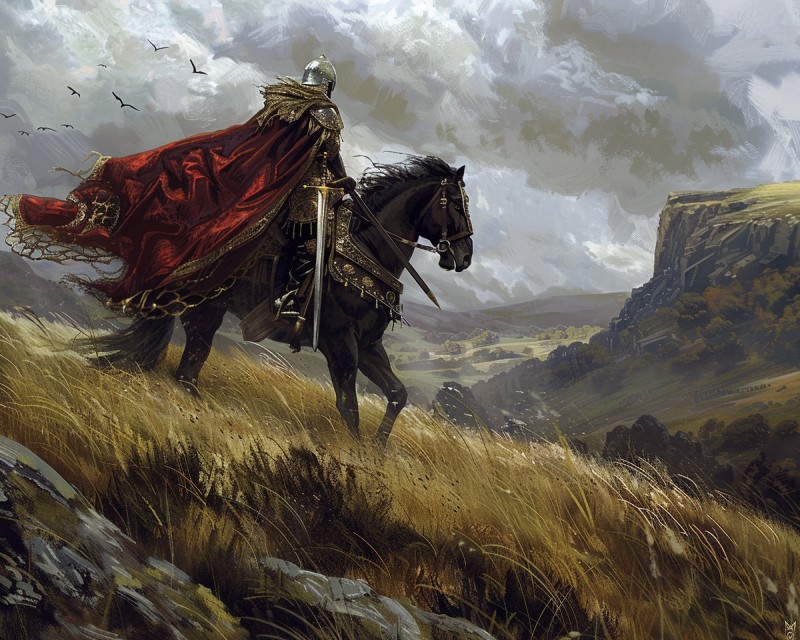
Long ago, in a land of green hills and ancient castles called Wales, there lived a brave and noble man named Owain Glyndŵr. Born in 1359, Owain grew up in a world of knights, kings, and legends, and he dreamed of one day making his own mark on history.
Owain lived peacefully on his family's land, where he loved to ride his horse through the valleys and listen to the birds sing. He was known for his kindness and wisdom, and he was respected by his people.
But one day, a powerful king from a faraway land wanted to rule over all of Wales. He took away the Welsh people's freedom, and that made them very unhappy. Owain Glyndŵr, who loved his country and its people dearly, could not stand to see them suffer. He gathered a group of friends, who also loved their country, and they made a promise to fight for Wales' freedom.
Owain's followers called him "Prince of Wales," and he became a hero to his people. They fought many battles together, sometimes winning and sometimes losing. Owain and his friends were very brave and always did their best, even when things got tough. The Welsh people were proud of Owain because he never gave up, and he always stood up for what was right.
After many years of fighting, Owain disappeared, and no one knows exactly what happened to him. But the people of Wales never forgot their brave hero. They told stories about his courage and wisdom, passing them down from generation to generation.
And so, even today, when the Welsh people see the green hills of their beautiful country, they remember the story of Owain Glyndŵr, the brave prince who fought for their freedom, and they are proud to call Wales their home.
The end.
History of Owain Glyndŵr:
Owain Glyndŵr, born around 1359, was a Welsh nobleman who became a national hero for leading a rebellion against English rule. Educated and of noble birth, he grew up to serve in the English army before returning to Wales. In 1400, amidst growing unrest over English control under King Henry IV and grievances over land disputes, he declared himself Prince of Wales and began a widespread revolt.
Glyndŵr's rebellion garnered significant support from various Welsh factions, and for several years, he managed to establish control over large parts of Wales. He held parliaments, formed alliances with France, and envisioned an independent Wales with its own parliament and church. Despite initial successes, his forces eventually lost momentum due to military setbacks, a lack of resources, and a lack of external support.
By 1412, the rebellion had largely collapsed, and Glyndŵr retreated into hiding. He disappeared from historical records and his final years remain a mystery. His legacy, however, endures as a symbol of Welsh nationalism and resistance. Owain Glyndŵr is celebrated for his vision of a free and self-determined Wales and is remembered as one of the country's greatest heroes.





